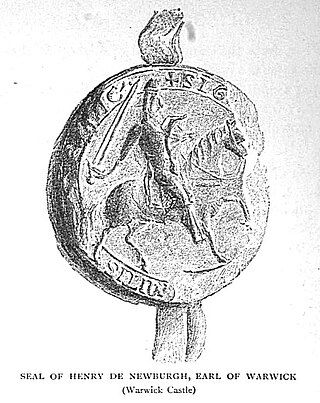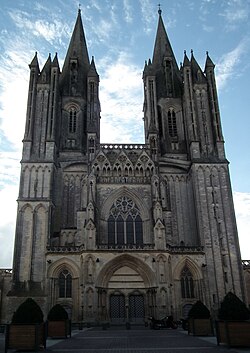
William I, usually known as William the Conqueror and sometimes William the Bastard, was the first Norman king of England, reigning from 1066 until his death in 1087. A descendant of Rollo, he was Duke of Normandy from 1035 onward. By 1060, following a long struggle to establish his throne, his hold on Normandy was secure. In 1066, following the death of Edward the Confessor, William invaded England, leading an army of Normans to victory over the Anglo-Saxon forces of Harold Godwinson at the Battle of Hastings, and suppressed subsequent English revolts in what has become known as the Norman Conquest. The rest of his life was marked by struggles to consolidate his hold over England and his continental lands, and by difficulties with his eldest son, Robert Curthose.

Odo of Bayeux, Earl of Kent and Bishop of Bayeux, was the maternal half-brother of William the Conqueror, and was, for a time, second in power after the King of England.

William de St-Calais was a medieval Norman monk, abbot of the abbey of Saint-Vincent in Le Mans in Maine, who was nominated by King William I of England as Bishop of Durham in 1080. During his term as bishop, St-Calais replaced the canons of his cathedral chapter with monks, and began the construction of Durham Cathedral. In addition to his ecclesiastical duties, he served as a commissioner for the Domesday Book of 1086. He was also a councillor and advisor to both King William I and his son, King William II, known as William Rufus. Following William Rufus' accession to the throne in 1087, St-Calais is considered by scholars to have been the new king's chief advisor.

Henry de Beaumont, 1st Earl of Warwick or Henry de Newburgh was a Norman nobleman who rose to great prominence in the Kingdom of England.

Richard II, called the Good, was the duke of Normandy from 996 until 1026.

Odo of Rennes, Count of Penthièvre, was the youngest of the three sons of Duke Geoffrey I of Brittany and Hawise of Normandy, daughter of Richard I of Normandy. Eudon married Agnes of Cornouaille, the daughter of Alan Canhiart, Count of Cornouaille and sister of Hoel II, Duke of Brittany who was married in 1066 to Eudon's niece Hawise, Duchess of Brittany.

The Rebellion of 1088 occurred after the death of William the Conqueror and concerned the division of lands in the Kingdom of England and the Duchy of Normandy between his two sons William Rufus and Robert Curthose. Hostilities lasted from 3 to 6 months starting around Easter of 1088.

Coutances Cathedral is a Gothic Catholic cathedral constructed from 1210 to 1274 in the town of Coutances, Normandy, France. It incorporated the remains of an earlier Norman cathedral.

Walter de Coutances was a medieval Anglo-Norman bishop of Lincoln and archbishop of Rouen. He began his royal service in the government of Henry II, serving as a vice-chancellor. He also accumulated a number of ecclesiastical offices, becoming successively canon of Rouen Cathedral, treasurer of Rouen, and archdeacon of Oxford. King Henry sent him on a number of diplomatic missions and finally rewarded him with the bishopric of Lincoln in 1183. He did not remain there long, for he was translated to Rouen in late 1184.

William of Talou, Count of Talou (Arques) was a powerful member of the Norman ducal family who exerted his influence during the early reign of William the Conqueror Duke of Normandy.
Aubrey de Coucy was the earl of Northumbria from 1080 until about 1086.
Robert de Mowbray, a Norman, was Earl of Northumbria from 1086 until 1095. Robert joined the 1088 rebellion against King William II on behalf of Robert Curthose, but was pardoned and later led the army that killed Malcolm III of Scotland at Alnwick. In 1095, he conspired to put Stephen of Aumale on the throne, was besieged by the king, and captured. As punishment, his marriage was dissolved and his lands confiscated, given to the new husband of his former wife, while Mowbray was imprisoned for life and later became a monk.

The Roman Catholic Diocese of Coutances (–Avranches) is a diocese of the Roman Catholic Church in France. Its mother church is the Cathedral of Coutance in the commune of Coutances in France. The diocese is suffragan of the Archbishop of Rouen and comprises the entire department of Manche. It was enlarged in 1802 by the addition of the former Diocese of Avranches and of two archdeaconries from the Diocese of Bayeux. Since 1854 its bishops have held the title of Bishop of Coutances (–Avranches).

Remigius de Fécamp was a Benedictine monk who was a supporter of William the Conqueror.

William the Conqueror had men of diverse standing and origins under his command at the Battle of Hastings in 1066. With these and other men he went on in the five succeeding years to conduct the Harrying of the North and complete the Norman conquest of England.
The trial of Penenden Heath occurred in the decade after the Norman Conquest of England in 1066, probably in 1076, and involved a dispute between Odo, Bishop of Bayeux, half-brother of William the Conqueror and Lanfranc, Archbishop of Canterbury and others.
Aubrey (Albericus) de Vere was a tenant-in-chief in England of William the Conqueror in 1086, as well as a tenant of Geoffrey de Montbray, bishop of Coutances and of Count Alan, lord of Richmond. A much later source named his father as Alphonsus.

The Domesday Book of 1086 lists in the following order the tenants-in-chief in Devonshire of King William the Conqueror:

The Abbey of the Holy Trinity is an 11th century Romanesque Benedictine Abbey church located in Lessay, Manche, France, then in Normandy. The abbey is one of the most important Norman Romanesque churches, and, along with Durham Cathedral, one of the first examples use of the rib vault to cover the choir in about 1098. This element became a key feature of Gothic architecture. The abbey was nearly destroyed in 1357. It was destroyed in 1944 and subsequently rebuilt.
Michael of Avranches was bishop of Avranches from 1068 to 1094. He was an Italian churchman, about whom very little is known before he became a bishop, only that he was a ducal chaplain of William II. According to Orderic Vitalis, he was 'a man of considerable learning and piety'.















